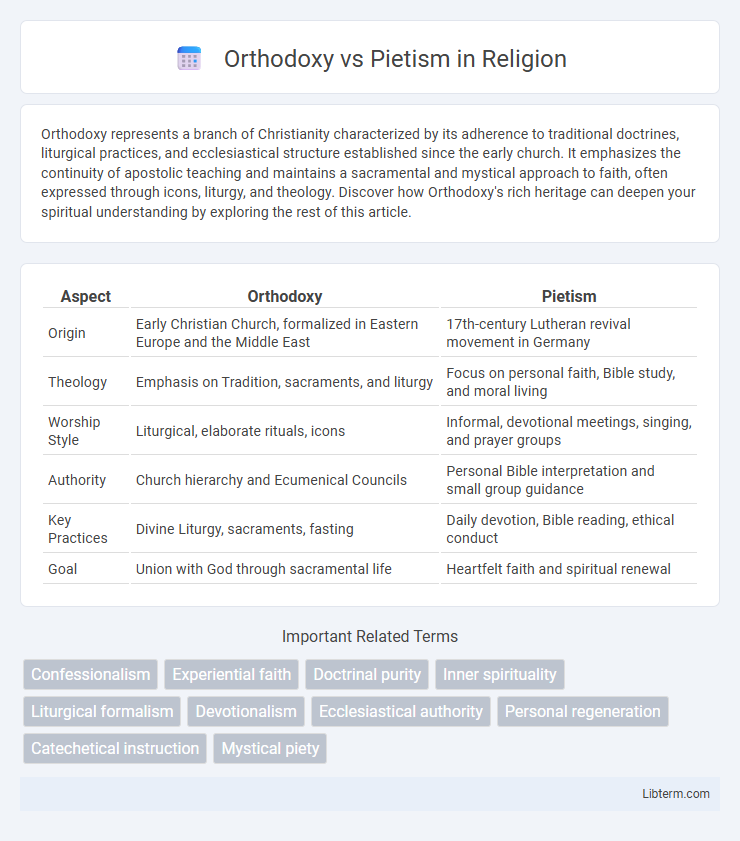Orthodoxy represents a branch of Christianity characterized by its adherence to traditional doctrines, liturgical practices, and ecclesiastical structure established since the early church. It emphasizes the continuity of apostolic teaching and maintains a sacramental and mystical approach to faith, often expressed through icons, liturgy, and theology. Discover how Orthodoxy's rich heritage can deepen your spiritual understanding by exploring the rest of this article.
Table of Comparison
| Aspect | Orthodoxy | Pietism |
|---|---|---|
| Origin | Early Christian Church, formalized in Eastern Europe and the Middle East | 17th-century Lutheran revival movement in Germany |
| Theology | Emphasis on Tradition, sacraments, and liturgy | Focus on personal faith, Bible study, and moral living |
| Worship Style | Liturgical, elaborate rituals, icons | Informal, devotional meetings, singing, and prayer groups |
| Authority | Church hierarchy and Ecumenical Councils | Personal Bible interpretation and small group guidance |
| Key Practices | Divine Liturgy, sacraments, fasting | Daily devotion, Bible reading, ethical conduct |
| Goal | Union with God through sacramental life | Heartfelt faith and spiritual renewal |
Defining Orthodoxy and Pietism
Orthodoxy emphasizes strict adherence to established doctrines and confessions, prioritizing formal theological precision and the preservation of historical creeds within the Christian faith. Pietism centers on personal spiritual renewal, heartfelt devotion, and practical Christian living, often highlighting individual piety over institutional religious formalism. The defining difference lies in Orthodoxy's focus on doctrinal correctness versus Pietism's emphasis on experiential faith and moral transformation.
Historical Origins and Background
Orthodoxy in Christianity emerged during the early centuries, rooted in formal creeds such as the Nicene Creed and emphasizing doctrinal consistency and ecclesiastical authority. Pietism originated in the late 17th century within Lutheranism, sparked by figures like Philipp Jakob Spener, focusing on personal faith renewal, heartfelt devotion, and practical Christian living. The historical background of Orthodoxy reflects established institutional traditions, while Pietism arose as a reform movement seeking deeper spiritual experience amid perceived religious formalism.
Core Beliefs and Doctrinal Emphases
Orthodoxy emphasizes adherence to traditional creeds, liturgical worship, and the sacraments as means of grace, with a strong focus on the incarnation and theosis in salvation. Pietism prioritizes personal Bible study, heartfelt devotion, and practical Christian living, highlighting individual conversion and moral transformation over formal doctrine. Both stress the importance of faith, but Orthodoxy centers on communal sacramental life, while Pietism stresses personal piety and experiential faith.
Worship Practices and Spiritual Disciplines
Orthodoxy emphasizes liturgical worship with structured rituals, sacraments, and a strong focus on the Eucharist, reflecting an ancient tradition that shapes spiritual life through communal participation and sacramental ceremonies. Pietism prioritizes personal devotion, heartfelt prayer, and Bible study, encouraging informal gatherings and individual spiritual disciplines aimed at fostering personal transformation and experiential faith. Both traditions value spiritual growth but differ in their approach to worship; Orthodoxy centers on communal liturgy, while Pietism highlights personal piety and ethical living.
Perspectives on Scripture and Authority
Orthodoxy emphasizes strict adherence to established creeds and hierarchical church authority rooted in tradition and formal interpretation of Scripture. Pietism prioritizes personal Bible study, experiential faith, and the individual's direct relationship with God, often challenging institutional authority. This contrast shapes their divergent views on scriptural interpretation--Orthodoxy relies on church tradition for authoritative understanding, while Pietism values subjective spiritual renewal and moral transformation inspired by Scripture.
Approaches to Salvation and Faith
Orthodoxy emphasizes salvation through adherence to established doctrines, sacraments, and church authority, viewing faith as a collective and institutional experience. Pietism prioritizes personal faith, heartfelt devotion, and a transformative relationship with God, stressing individual piety and moral renewal. Salvation, in Pietism, is experienced through personal conversion and ethical living rather than formal ritual observance.
Community Life and Church Structure
Orthodoxy emphasizes a hierarchical church structure grounded in apostolic succession and liturgical tradition, fostering a strong communal worship experience through prescribed sacraments and rites. Pietism, by contrast, prioritizes personal faith and devotional practices within small, informal groups, often encouraging lay participation and mutual accountability beyond formal ecclesiastical authority. The communal life in Orthodoxy revolves around the institutional church's sacramental calendar, whereas Pietism centers on individual spiritual renewal and community bonding through Bible study and prayer meetings.
Critiques and Controversies
Orthodoxy faces critiques for rigid dogmatism and resistance to theological development, which some argue stifles personal spiritual experience. Pietism, while praised for emphasizing personal piety and heartfelt devotion, is sometimes criticized for encouraging emotionalism and downplaying doctrinal precision. Controversies arise over Orthodoxy's perceived formalism contrasted with Pietism's potential to foster individualism that may challenge ecclesiastical authority.
Lasting Influences on Modern Christianity
Orthodoxy shaped modern Christianity through its emphasis on doctrinal continuity, liturgical tradition, and sacramental theology, deeply influencing Eastern Orthodox and some Western churches. Pietism propelled a personal, experiential faith marked by Bible study, moral reform, and revivalism, significantly impacting Protestant denominations and evangelical movements. These distinct legacies continue to inform contemporary Christian worship styles, theological priorities, and community life worldwide.
Orthodoxy and Pietism: Ongoing Relevance Today
Orthodoxy emphasizes strict adherence to traditional doctrines and liturgical practices, providing a stable theological framework that continues to influence contemporary Christian worship and identity. Pietism prioritizes personal faith experience and devotional life, encouraging believers to cultivate heartfelt spirituality and ethical living, which resonates in modern movements seeking authentic religious expression. Both Orthodoxy and Pietism remain relevant by addressing diverse spiritual needs, balancing communal tradition with individual piety in today's religious landscape.
Orthodoxy Infographic

 libterm.com
libterm.com